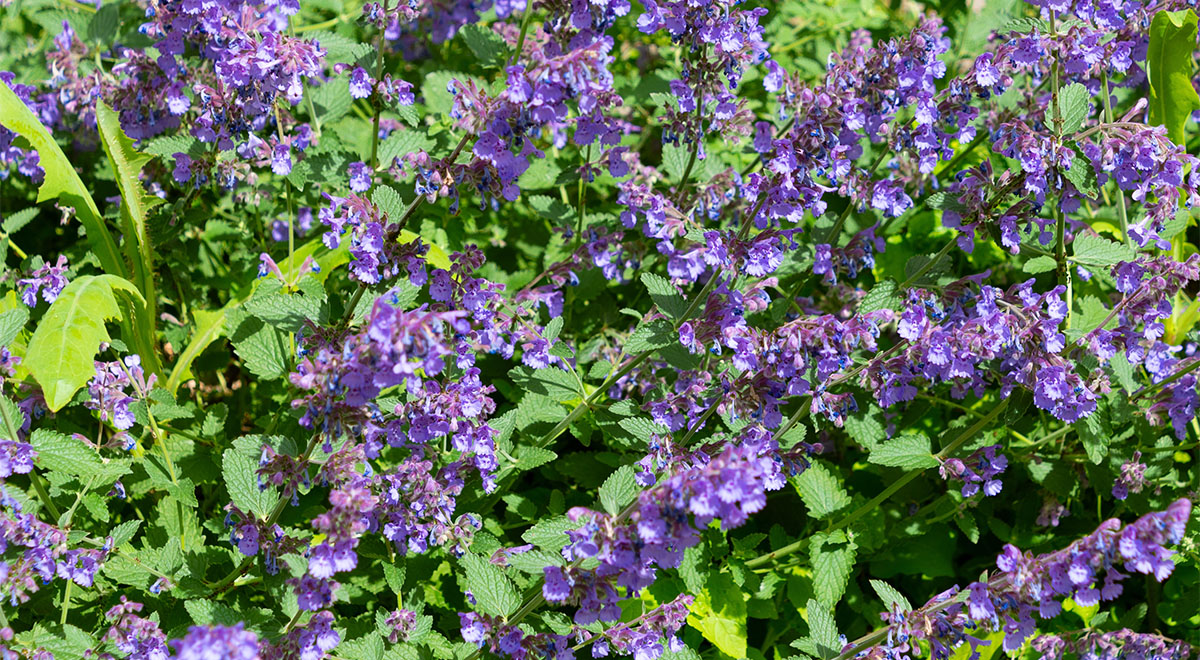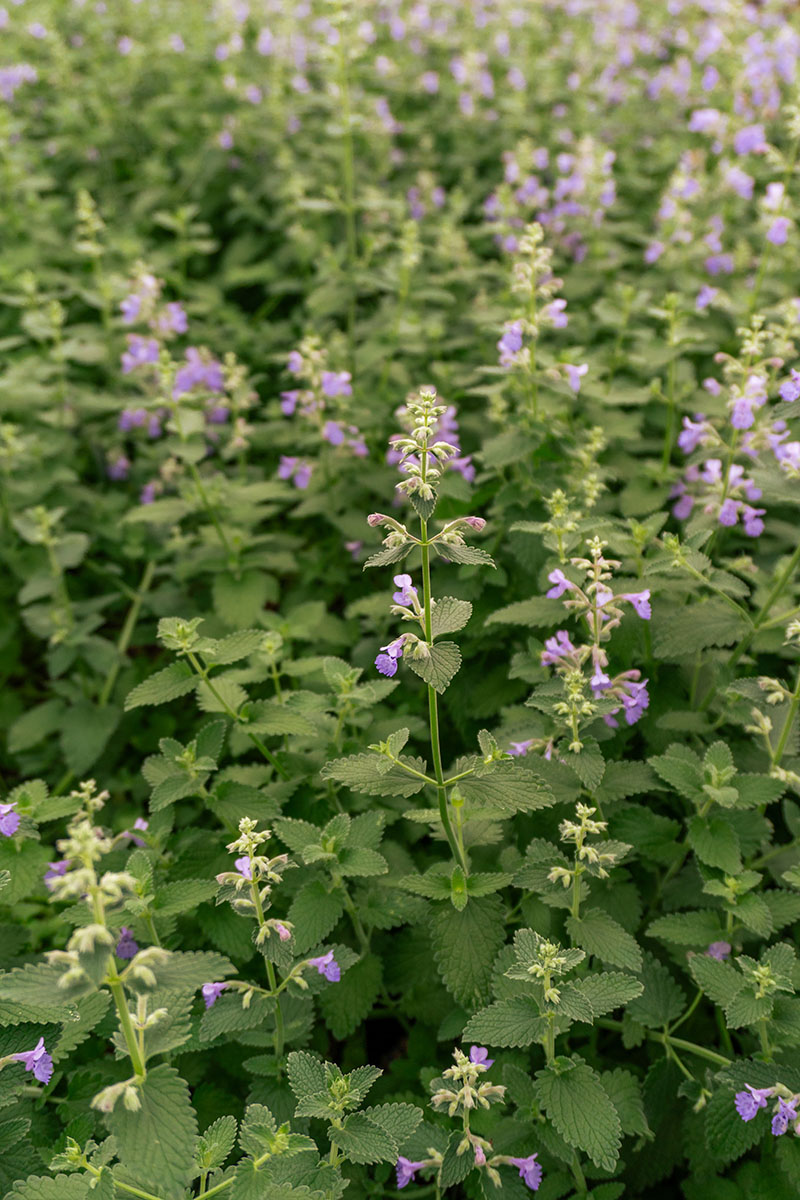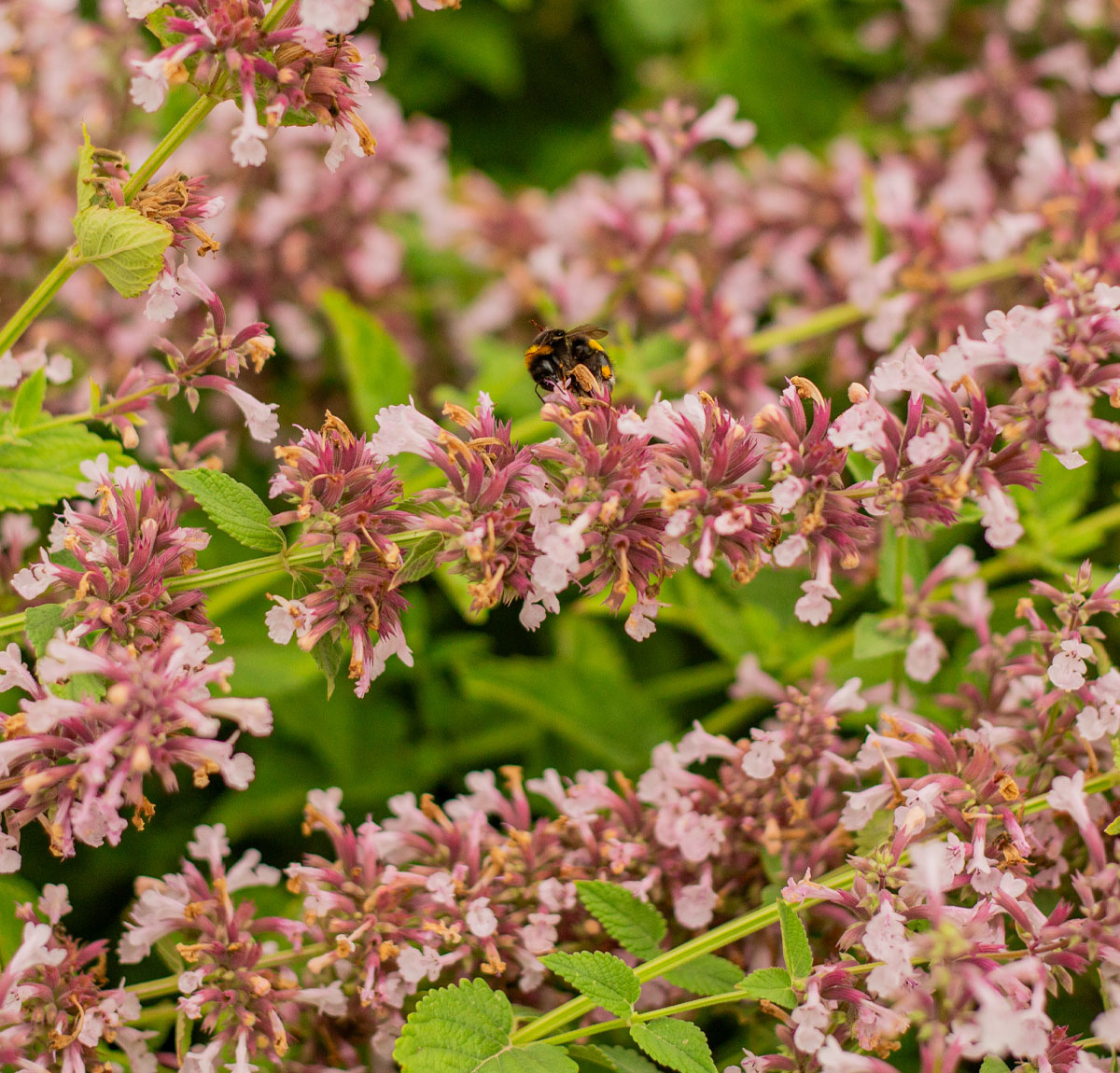Plant focus: Nepeta
A hardy, pollinator-friendly perennial that brings colour, scent, and texture to planting schemes.
Nepeta, commonly known as catmint, is a genus of aromatic perennials and shrubs that belongs to the mint family, Lamiaceae. There are around 250 species within the genus, native to a wide geographical range that includes southern and eastern Europe, Asia, and parts of northern Africa. Many species thrive in dry, rocky habitats, and their ability to cope with poor soils and harsh conditions is one of the reasons they are so well suited to modern sustainable landscaping in the UK.
The name Nepeta is thought to derive from the ancient Italian town of Nepete (now called Nepi), where the plant was grown back in Roman times. Historically, Nepeta was used for both ornamental and practical purposes. Its fragrant leaves were used in traditional herbal medicine for their calming and digestive properties, and the plant was often included in monastery and physic gardens. Nepeta has long been noted for its curious effect on cats. The chemical compound nepetalactone, found in the leaves and stems, triggers a playful or relaxed response in many domestic cats, which is how the common name ‘catmint’ arose.
In the UK, Nepeta species have been grown in gardens since at least the 18th century, valued for their soft, aromatic foliage, long-lasting sprays of blue or violet flowers, and their appeal to pollinators such as bees and butterflies. Today, Nepeta is widely used in planting schemes for its reliability, tolerance of poor soils, dry conditions, and its ability to provide a natural, flowing character to landscape designs. Its low maintenance nature and long flowering season make it a favourite choice for modern schemes.
Key Characteristics:
✓ Hardy perennial or subshrub
✓ Aromatic, grey-green or silvery foliage
✓ Spikes of small, tubular blue or violet flowers
✓ Typical height ranges from 30cm to 90cm
✓ Thrives in full sun and well-drained soils
✓ Tolerant of drought once established
✓ Low maintenance and long flowering
✓ Ideal for borders, edging, ground cover, and pollinator planting
✓ Flowers mainly from late spring through summer
Did you know?
Nepeta’s nickname, catmint, comes from the fact that many cats are drawn to the scent of its leaves. The essential oil nepetalactone, found in the foliage, is what triggers the playful or relaxed behaviour in cats.
Popular Nepeta varieties we grow and sell:

Nepeta faassenii
Nepeta faassenii
This compact hybrid forms soft mounds of aromatic grey-green foliage, topped with masses of lavender-blue flower spikes from late spring to autumn. As a sterile variety, it doesn’t self-seed, making it ideal for keeping planting schemes tidy. Perfect for edging paths, filling gaps in borders, or softening hard landscaping features.
Nepeta racemosa (syn. Nepeta mussinii)
A low-growing, neat variety with small grey leaves and vivid blue flowers. Works well at the front of borders, in rockeries, or for softening the edges of paving. Brings a natural, informal feel to planting schemes, easy to manage in tight spaces.
Nepeta × faassenii ‘Walker’s Low’
RHS award-winning variety that reaches around 60cm in height. Produces arching stems covered in violet-blue flowers over a long season. Graceful, sprawling habit creates a soft, flowing effect, making it ideal for planting alongside paths or in mixed borders where a relaxed look is desired.
Nepeta ‘Six Hills Giant’
A vigorous and larger cultivar that can grow up to 90cm tall and wide. It forms airy, billowing clumps of grey-green foliage topped with pale violet-blue flowers. Perfect for larger planting schemes, where it adds impact and helps create a relaxed, naturalistic feel.

Nepeta × faassenii ‘Walker’s Low’

Nepeta ‘Six Hills Giant’
Nepeta ‘Junior Walker’
A dwarf, compact form of ‘Walker’s Low’ which grows to just 30–40cm. Offers the same aromatic silvery foliage and lavender-blue flowers but with a tidy, mound-forming habit. Well suited to containers, raised beds, and small urban gardens, where space is limited.
Nepeta ‘Cat’s Pyjamas’
A modern, compact variety that blooms earlier than many other Nepetas. It produces dense clusters of deep indigo-blue flowers that cover the entire length of the stems, creating a rich display. The neat, rounded shape and long flowering season make it a great choice for small-scale landscaping and urban planting schemes.
Nepeta grandiflora ‘Dawn to Dusk’
An upright, clump-forming perennial with soft shell-pink flowers and dusky calyces, flowering from early to midsummer. Reaching around 70cm tall, it features aromatic green foliage that attracts bees and other pollinators. This variety prefers full sun and well-drained soil, and is ideal for naturalistic borders or pastel-themed planting schemes. Drought tolerant once established and very low maintenance.

Nepeta grandiflora ‘Dawn to Dusk’
How to Grow and Care for Nepeta
Nepeta is a versatile and easy to grow, suiting a wide range of planting schemes. It thrives in full sun, where it produces the most flowers and maintains its neat, compact habit. While it will tolerate partial shade, plants may become more open and produce fewer blooms. Sunny spots along borders, beside paths, or in raised beds are ideal for showcasing this plant’s airy beauty.
Well-drained soil is key to growing healthy Nepeta. It copes well with a variety of soil types, including sandy, chalky, or light loams, and can even grow in poorer soils. The main requirement is that water does not sit around the roots, particularly in winter, as this can cause root rot. In heavier clay soils, consider planting in raised beds or improving drainage with grit or organic matter to prevent waterlogging.
Plant Nepeta in spring or autumn, spacing the plants according to variety. Compact types like Nepeta racemosa can be spaced around 30cm apart, while larger types like ‘Six Hills Giant’ may need 60 to 90cm between plants to give them room to spread naturally. Water well after planting until the roots are established. Once settled in, Nepeta is drought tolerant and generally does not require additional watering except during prolonged dry spells. It thrives in low-fertility soils, so feeding is rarely needed. In fact, rich soils or heavy feeding can encourage excessive leafy growth at the expense of flowers.
Nepeta benefits from a light pruning after the first flowers fade in midsummer. This helps maintain a tidy shape and often encourages a second bloom later in the season. In late autumn or early spring, cut back dead or untidy growth to ground level to promote healthy new shoots. Every few years, larger clumps can be lifted and divided in spring or autumn to rejuvenate the plants and prevent them from becoming woody at the centre. Nepeta pairs beautifully with roses, ornamental grasses, lavender, and salvia. Its soft, airy growth and cool-coloured flowers provide a perfect foil for bolder plants, and it is excellent for softening hard landscaping features such as paving edges or retaining walls.
Pests and Diseases
Nepeta is generally a robust and reliable plant that suffers from few serious pests or diseases, making it a favourite for low-maintenance planting schemes. However, there are still a few issues that gardeners and landscapers should keep in mind to ensure plants stay healthy and looking their best.
Although relatively uncommon, young Nepeta plants can be vulnerable to slug and snail damage, especially in damp conditions or in the early stages of growth when stems and leaves are soft. Protecting newly planted specimens with barriers or deterrents can help prevent harm. Once established, the aromatic foliage tends to deter these pests.
Occasionally, aphids may appear on fresh shoots in spring or early summer. These small sap-sucking insects can cause distortion of new growth, though infestations are rarely severe on Nepeta. Encouraging natural predators such as ladybirds and lacewings, or simply washing the aphids off with water, is usually sufficient.
In terms of diseases, Nepeta is largely trouble-free. The main risk comes from root rot, particularly in heavy soils where drainage is poor. Prolonged waterlogging can lead to the roots decaying, causing plants to fail. To avoid this, it’s important to plant Nepeta in well-drained soil or raised beds, and to improve drainage where necessary, especially on clay sites.
If you would like more information on the varieties of Nepeta we grow and sell, get in touch with the G Team today.
To learn more about the different types of Choisya that we grow and sell, speak to the G Team today.

